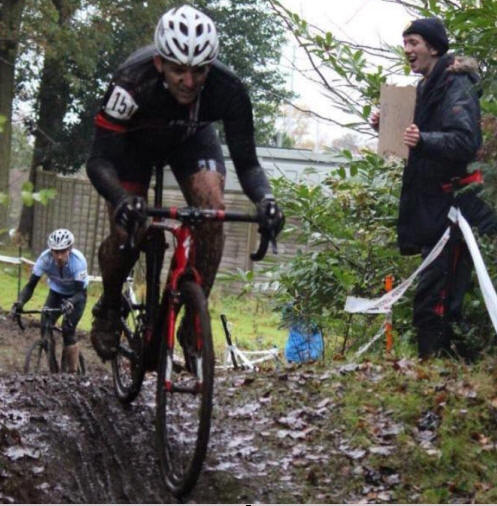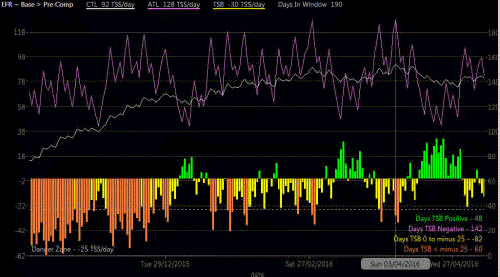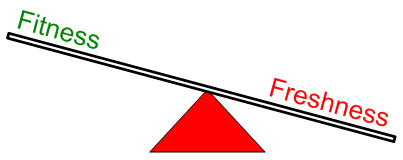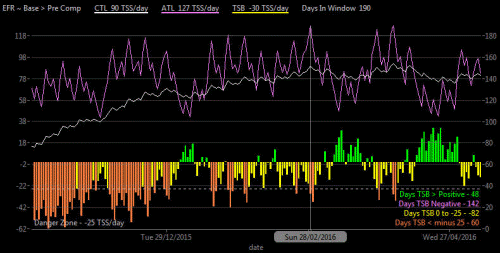FAQ ~ Racing & CTL Loss?

Malcolm Cooper ~
living the dream
CTL and the track dropping, with fitness and fun increasing
photo ~ Paula Stronach
With the CX season in full swing and a weekly
routine of rest, a couple of short/hard sessions, rest, then race,
I've noticed a constant decline of my CTL on my PMC within Training
Peaks.
These training/racing efforts aren't positively influencing my PMC
and the numbers don't match my feelings, leading me to question
their validity (realising it's 'guidance only').
Malcolm Cooper ~ UK
Not only has Malcolm (above) spotted an "idiosyncracy" with his effort and rewards, he's identified the solution and was really seeking clarification as to why this should be.
First a quick overview of the terms used.

Base Build to Early Comp Performance Management Chart
Chronic Training Load
The PMC (Performance Management Chart) above, is from my build up
to the 2016 season. The white line is CTL
(Chronic Training Load); this is the workload applied to the
body over an extended period of time. It's a marker of our fitness and is
presented over a rolling 42 day period.
The training you did up to six weeks ago still has a contributory effect on your current fitness; although obviously less so than work done last week.
To push CTL up, the purple lined Acute Training Load has to remain higher than the white line.
Paradoxically, the fitter you get, the more and the harder (volume and intensity), you have to create to raise that fitness level.
Luckily, the higher your CTL, the more training load you can absorb. Which presents you with a virtuous, but ultimately viciously destructive, fitness circle. What's a rider to do?
Acute Training Load
Frustratingly, the higher the CTL, the slower it
rises. This can clearly be seen by the rapid (white) rise rate on the
left of the chart. And even though, as it reaches the middle, the (purple ATL) workload continues to increase, the
white CTL rise rate
slows.
Chronic Training Load is created through the cumulative effect of the purple lined, ATL (Acute Training Load). ATL is "seven day near-time", and is measured over a rolling week.
To maintain an upward CTL, this weeks training has to be harder than last weeks, and next weeks has to be harder than this. As discussed earlier, the harder your trianing is, the harder it is it increase the intensity.
Training Stress Balance
As the great Isaac Newton told us, every action has an equal and
opposite reaction. When CTL fitness goes up, something has to
go down, and that's your "freshness".
The orange/yellow/green bars are indicators of your TSB (Training Stress Balance); reflecting your "recoverability" and your ability to perform.
The orange bars indicate a stress deeper than -25, not a good place to be! Once you are "in the race zone", you don't want to be seeing orange bars in your taper period!
Yellow is "normal" fatigue, and green is when you're good to go, fresh and capable of performing.

It's a bit difficult to see in this chart; but the top line, end right indicator tells us there are 190 days selected in this "training period. Base to the end of Pre-Comp. The bottom right corner gives you the breakdown of those 190 days.
In this whole period there were only 48 (green) days of positive TSB. Christmas week, the end of February to prepare for Speed Work (where the vertical marker is) and the start of the racing season.
There were 142 days of fatigue; 82 "normal" fatigue and 60 "super" fatigue days, predominantly, in the run up to Christmas, and the completion of the Base Build period.
Goldilocks Principal
Looking at the chart above,
we'll begin at the bit you can't see! CTL is coming in from a
low base. To the left of the orange bits, it's very, very
green, as I'd had an excellently slack,
Slacktober.
We've discussed the fitness see-saw before, so here it is in pictorial form. It can be seen from the PMC that this was my fitness/freshness balance, starting my Base Build in October...

November ~ here we go again....
CTL came in at a derisory 15 TSS and TSB at an extraordinary +45! I was fit for nothing, but very fresh!
I worked "controllably" hard, keeping to a progressive schedule and started to build my fitness as the winter unfolded.

In the last week of February there was a big push with the highest ATL of the year at 83 TSS/day, taking CTL to 81 and TSB down to -37, which was my 57th day of the winter below -25 TSB. Which left me a little bit like this...

February ~ getting there, but not feeling the love...
Remember, I don't have a job; these numbers don't reflect a "real person", living in the real world, with real things to do!
Going in to March saw my highest level of fitness of the year, but too fatigued to do anything with it.
Time for a taper. Which brings us to Malcolm's point!
Racing, is like an "unstructured taper". Your normal training volume is, by necessity, cut down, as you concentrate on race efforts, at a higher intensity. Which means you recover more. You also lose training days (or gain recovery days) through travelling; which is a good thing!

Finding The Balance
You can clearly see,
from the purple ATL line, running from the left, our three weeks on, one week off, training
pattern.
The first green TSB section, is Christmas Week; our programmes are timed to ensure we all get a "grey week" at Christmas. The one in March, is a planned taper to hold back CTL and allow an adaptation rebound.
The rouge green bars are when it lashed it down at the weekend, and I "took a sickie..."
After our March hiatus, when CTL has successfully dipped, and positive TSB is restored, we are fresh to do our Speed Work. Which comprises much shorter efforts, but at a much higher intensity. A bit like Malcolm's racing escapades.
Starting the speed training (or racing) block we now have a CTL of 78 with a TSB ranging between +10 and +20.
The last time our CTL was at 78, was in January's Climbageddons, when TSB was dipping in to the -40's. These are the three orange dips in the centre of the chart. From -40 to +20 with the same CTL; imagine how that feels?
This is a perfect (even though I say so myself) example of how we manipulate fitness and freshness and time it just right to peak for specific periods or competitions.
For the last bit of our chart to the right, where the green cluster is, we have a training balance that's "just right"...

April ~ everything in place; where's me shorts...?
This is exactly where you want to be for your racing efforts. Cross is a bit different, in that you have to hold a "sustained peak" for an extended period of time, which is what makes it (and the riders) so special. You need to come in to the season slightly "under-cooked".
It's a bit like the Classic riders who peak for a single day, and the Tour riders that have to be high, but not at peak fitness, at the start of a stage race. If you peak for the first race of a Cross Series, it ain't gonna end well. Timing is everything.
Fitness, Fatigue, Performance
This chart below, tracks my top five efforts over three key
performance markers during the period in the PMC we've used above.
![]()
You can see my best 5 minute (VO2max) effort, and two of my top-five 20 minute efforts came during the right hand "green period" when CTL was dipping but freshness was rising.
Nearly all the other markers fall during green TSB peaks on the PMC. Fresh beats fit every time.
The Answer!
To answer Malcolm's question,
Yep, CTL will drop during the racing period, but CTL isn't the single determining factor
to success. It's an important one, but not the only, marker
for fitness.
For Cross racing, you "only" have to be fit enough to to ride for an hour. So your CTL, an indicator of aerobic endurance capacity, doesn't have to be ridiculously high. You need a pretty big CTL for an IronMan event, but not a cross race or a ten mile TT.
For Cross, apart form excellent bike handling skills; you need a high Pmax, VO2max, and fatigue resistance. These are all developed with "intense" efforts, so will be of a shorter duration. Which means you can't drive your CTL up as you won't have the training volume!
What's more important is that you are fresh and ready to go on the day. Let CTL drop, maintain your "freshness" and ride it like you stole it.
Everyone else in the event is in the same dilemma. It's not like everyone else is building CTL by training like a pro during the week and performing at the weekend!
Never compromise recovery for building CTL and perceived fitness; especially during the race season.
Suffer Well...








